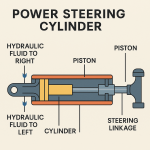The Power Steering Cylinder is a key component of the car's power steering system. Its function is to make it easier for the driver to turn the steering wheel, especially when parking or driving at low speeds. Here is how it works, explained in simple language:
1. Basic structure
The power steering cylinder usually includes:
Cylinder body: Like a metal cylinder with a piston inside.
Piston rod: Connected to the steering device (such as the steering tie rod).
Hydraulic oil inlet: There is an oil inlet on each end, which is connected to the steering pump.
2. Working principle
When you turn the steering wheel, the vehicle's power steering pump will press the hydraulic oil into one side of the cylinder:
If you turn the steering wheel to the left, the oil will be pressed into the right side of the cylinder, pushing the piston to the left and helping to turn the tire.
If you turn the steering wheel to the right, the oil will be pressed into the left side of the cylinder, pushing the piston to the right.
This hydraulic force reduces the burden of turning the steering wheel.
3. Functions and benefits
Effort saving: It is easier to turn the steering wheel, especially at low speeds.
More precise control: Make the steering wheel more sensitive.
Safer driving experience: Faster response in emergency steering.
The power steering cylinder uses the pressure of hydraulic oil to help drive the vehicle's steering system, making driving easier and safer.


